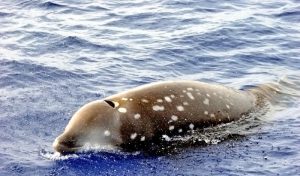Study Estimates Beaked Whale Populations in Gulf of Mexico
– May 29, 2016
Scientists used passive acoustic monitoring during 2010-2013 to detect the presence of beaked whales in the Gulf of Mexico. These animals are difficult to study visually because they spend little time at the sea surface and are only present in offshore deep waters; they are rarely found on the continental shelf and near-shore waters.
Analysis of acoustic recordings found two dominant beaked whale species in the Gulf, Gervais’ (66% of total encounters) and Cuvier’s (50% of total encounters). The Gervais’ whale was the dominant species at the western study sites (Mississippi Canyon and Green Canyon), and the Cuvier’s whale was the dominant species at the eastern study site (the Dry Tortugas). There were no beaked whale detections at sites on the continental shelf (Main Pass and DeSoto Canyon). This study provides data for modeling potential long-term whale population responses to the Deepwater Horizon spill and other environmental conditions. Researchers published their findings in Scientific Reports: Passive acoustic monitoring of beaked whale densities in the Gulf of Mexico.
Beaked whales dive deep (500 – 1,300 meters) and depend on echolocation pulses to find their prey, which is thought to be deep-water squid. The team estimated the whales’ population density during their deep dives by counting echolocation clicks on a weekly basis and also by determining whales’ presence or absence in five-minute periods. Results from both methods were in general agreement. Encounters of Gervais’ beaked whales were mainly in groups of two to five animals and Cuvier’s beaked whales were in smaller groups of one to four animals.
Study author John Hildebrand said, “Our study was the first time we were able to monitor the presence of these two beaked whale species.” Hildebrand explained that by listening to their sounds, they kept track of the whales in areas near the oil spill and in areas not directly impacted by the spill. Looking ahead, Hildebrand said, “We will apply the same method to several other species such as sperm whales and get a sense of how these deep-diving cetaceans of the Gulf responded to the spill.”
The study’s authors are John A. Hildebrand, Simone Baumann-Pickering, Kaitlin E. Frasier, Jennifer S. Trickey, Karlina P. Merkens, Sean M. Wiggins, Mark A. McDonald, Lance P. Garrison, Danielle Harris, Tiago A. Marques, and Len Thomas.
************
This research was made possible in part by a grant from the Gulf of Mexico Research Initiative (GoMRI) to the Center for the Integrated Modeling and Analysis of the Gulf Ecosystem (C-IMAGE). Other funding included Natural Resource Damage Assessment partners (20105138); US Marine Mammal Commission (20104755/E4061753); Southeast Fisheries Science Center under the Cooperative Institute for Marine Ecosystems and Climate (NA10OAR4320156) with support through Interagency Agreement (#M11PG00041) between the Bureau of Offshore Energy Management, Environmental Studies Program and the National Marine Fisheries Service, Southeast Fisheries Science Center; US Navy Living Marine Resource Program; US Office of Naval Research (N000141210418, N00014-07-10988, N00014-07-11023 and N00014-08-10990); U.S. Strategic Environmental Research and Development Program (SI-1539); and the Marine Alliance for Science and Technology for Scotland by the Scottish Funding Council (HR09011).
The Gulf of Mexico Research Initiative (GoMRI) is a 10-year independent research program established to study the effect, and the potential associated impact, of hydrocarbon releases on the environment and public health, as well as to develop improved spill mitigation, oil detection, characterization and remediation technologies. An independent and academic 20-member Research Board makes the funding and research direction decisions to ensure the intellectual quality, effectiveness and academic independence of the GoMRI research. All research data, findings and publications will be made publicly available. The program was established through a $500 million financial commitment from BP. For more information, visit https://gulfresearchinitiative.org/.
© Copyright 2010- 2017 Gulf of Mexico Research Initiative (GoMRI) – All Rights Reserved. Redistribution is encouraged with acknowledgement to the Gulf of Mexico Research Initiative (GoMRI). Please credit images and/or videos as done in each article. Questions? Contact web-content editor Nilde “Maggie” Dannreuther, Northern Gulf Institute, Mississippi State University (maggied@ngi.msstate.edu).






